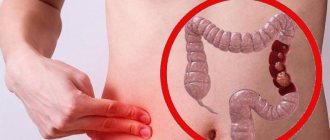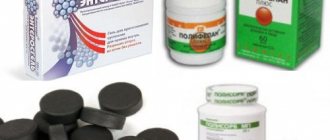Vacation is perhaps the most awaited event of the year. This is an opportunity to bask on the beach under the gentle rays of the sun, enjoy the sound of the sea surf, plunge into cool water, see the sights, get acquainted with the culture of another country - in a word, change your usual surroundings and take a break from everyday life. Many hotels offer their guests buffet meals. With this method of serving, all dishes are freely placed on separate tables, and each guest can choose what he likes without any restrictions.
However, the “buffet” not only offers us complete freedom of choice, it is fraught with danger: the variety of dishes makes our eyes wide open, we want to try everything, and in the end, overestimating the capabilities of our own body and not knowing the limits, we overeat. Even for a completely healthy person, such a large meal is not an easy test, but what can we say about those who have digestive problems... The result is heaviness in the stomach, nausea, discomfort after eating, which can overshadow any trip.
Causes of food vomiting
In most cases, the appearance of the symptom is caused by various morphological or functional disorders of the digestive system. Physiological reasons include overeating, which is accompanied by stretching of the gastric wall and reflex stimulation of the vomiting center in the medulla oblongata. The symptom is most often provoked by eating large amounts of heavy food with alcoholic beverages. Vomiting food is also one of the manifestations of toxicosis in the first half of pregnancy.
Pyloric stenosis
Vomiting of eaten food is a common symptom of narrowing of the transition between the stomach and duodenum, which can be either congenital or associated with organic lesions of the gastroduodenal zone. With pyloric stenosis, a long-term retention of chyme in the stomach occurs, which causes overstretching of the organ. Nerve impulses from the receptors are transmitted primarily through the vagus nerve to a specific center of the brain, which triggers a sequential act of vomiting.
The frequency of vomiting attacks depends on the severity of the stenosis. With mild to moderate degree of narrowing of the pyloric sphincter, the manifestation is observed once every few days. With decompensated pyloric stenosis, antiperistaltic contractions occur after each meal. Vomit has a rotten smell. Characterized by constant heaviness and dull pain in the epigastrium, a feeling of fullness in the stomach, bloating. With a long course of the disease, exhaustion progresses up to complete cachexia.
Poisoning
Dyspeptic disorders are the main symptoms of food poisoning caused by the consumption of low-quality products contaminated with staphylococci, enterobacteria and other pathogens. An attack of vomiting occurs a couple of hours after eating and is combined with diarrhea, cramping abdominal pain, and signs of general intoxication. Excitation of the vomiting center is caused by massive exposure to toxins; the direct irritating effect of microbes on the gastric mucosa plays an important role.
Gastritis
The appearance of vomiting food is more typical for acute gastritis, which is accompanied by pronounced organic changes in the gastric mucosa. The symptom in most patients occurs immediately after eating food due to irritation of the nerve endings. A typical combination of vomiting with sharp pain in the epigastric zone, constant nausea and belching of air. Vomit may contain mucus and bile. Diarrhea is also observed up to 7-10 times a day, which sometimes leads to dehydration.
Gastroduodenal diseases
In diseases of the stomach and duodenum, vomiting is a reflex in nature and is preceded by nausea. The symptom is caused by excessive stimulation of the center of the medulla oblongata along the fibers of the vagus and phrenic nerves. Many patients note an improvement in their well-being after vomiting, so they sometimes induce vomiting on their own. Typical complaints are abdominal pain, flatulence, diarrhea, and constipation. Vomiting of gastric chyme with food is manifested by:
- Gastroparesis
. A decrease in the contractility of the gastric muscles predisposes to the appearance of antiperistaltic contractions, which cause vomiting with the release of large amounts of food. Patients complain of nausea after eating, a feeling of fullness in the epigastrium, belching of air or rotten food. Repeated vomiting is observed in severe cases of the disorder, when chyme stagnates in the stomach for several days. - Acute gastric dilatation
. The clinical picture of the disease develops acutely due to disruption of the innervation of the gastric wall. There are sharp pains in the epigastric region, which are combined with nausea and hiccups. Indomitable vomiting is observed with the release of gastric contents with food (up to 8 liters per day), then bile may appear in the vomit. Vomiting occurs without any volitional effort and does not bring relief. - Duodenal stenosis
. Regurgitation of eaten food indicates a decompensated state when the gastric muscles cannot cope with the large volume of chyme received as a result of duodenogastric reflux. Other dyspeptic disorders are possible: nausea after eating, rotten belching, sometimes patients complain of heartburn. Characterized by pain, a feeling of heaviness in the stomach. - Adductor loop syndrome
. In this variant of diseases of the operated stomach, partially digested chyme accumulates in the cecum, and the condition is aggravated by increased secretion of intestinal juice. With significant expansion of the intestine, duodenostasis begins, which is complicated by jejunogastric reflux with profuse vomiting of food eaten. As a rule, the general condition is disturbed and intoxication increases. - Neoplasms
. Vomiting of food often occurs when tumors are localized in the pyloric part, when they impede the passage of chyme into the underlying parts of the digestive tract. Benign formations develop asymptomatically; clinical signs appear only when the polyp is large. In case of malignant tumors, the vomit contains blood impurities; in severe situations, vomiting “coffee grounds” begins.
Functional dyspepsia
Non-organic stomach disorders are characterized by the polymorphism of clinical signs, their rapid appearance and disappearance. Dyspeptic symptoms are usually preceded by errors in diet and stressful situations. Habitual vomiting is typical, occurring suddenly and associated with the effects of higher nervous structures on the medulla oblongata. In addition to regurgitation of food, flatulence, heaviness in the epigastrium, and stool instability are possible. Against the background of dyspeptic symptoms, symptoms of vegetative-vascular dystonia often appear.
Pathologies of the esophagus
In the pathogenesis of esophageal vomiting, disturbances in the coordination of contractions of the sphincters and smooth muscle layer, as well as mechanical obstacles that impede the passage of food, are of great importance. A distinction is made between early vomiting, which occurs directly during eating and is caused by mechanical obstruction, and late vomiting, which is a manifestation of functional changes in the functioning of the muscle sphincters. The symptom is combined with dysphagia and chest pain. The most common causes of vomiting are:
- Esophageal stenosis
. In the case of congenital stenosis, symptoms in the form of regurgitation of uncurdled milk are detected already in the first days of life. With acquired narrowing, the first sign is dysphagia, first of solid foods, and then of semi-liquid and liquid foods. The retention of the food bolus over the site of stenosis and the expansion of the organ provokes vomiting. The entry of particles into the respiratory tract predisposes to coughing attacks, shortness of breath, and suffocation. - Esophageal diverticula
. The formation of a saccular protrusion of the wall often occurs in older people, who often suffer from other gastrointestinal pathologies. Food accumulates in the formation, which is then released during vomiting. For diverticulum, the presence of chest pain, bad breath, and rotten belching is pathognomonic. Due to the improvement in the condition after vomiting, many patients induce it artificially. - Dyskinesia
. Regurgitation of just eaten food is possible with any violation of the contractile activity of the esophageal muscles. The symptom often occurs with hypomotor dyskinesia with prolonged retention of food masses at the entrance to the stomach. In addition to vomiting, swallowing disorders are determined, and with functional disorders, patients experience difficulty swallowing liquids, but solid food passes without problems. - Achalasia cardia
. When there is a disturbance in the innervation of the lower esophageal sections, the cardiac sphincter reflexively closes, which makes it difficult for food to pass into the stomach. The esophagus expands, and stagnation of food masses develops. This leads to regurgitation due to contraction of the esophageal muscles and is manifested by profuse regurgitation “a mouthful”. Patients experience dysphagia when taking both liquid and solid foods. - Ulcerative defect
. For lesions of the esophageal mucosa, the appearance of sharp chest pain and heartburn immediately after eating is pathognomonic. At the height of pain, vomiting begins, which brings relief. In addition to the food eaten, blood is found in the discharged masses, indicating bleeding from the ulcer. With a prolonged course of the disease, significant loss of body weight up to cachexia is observed.
Prevention of overeating
To avoid ruining your holiday due to stomach problems, it is important to avoid overeating at all, even though in the case of a buffet the temptation is very high. What to do?
Here are some simple recommendations:
- Pay more attention to fresh fruits and vegetables. In addition to the fact that it is a real storehouse of vitamins, it is also a source of enzymes, which, as we have already said, help digestion.
- Before filling your plate with food, inspect the entire range of dishes on offer, because much of what you took at first may turn out to be unnecessary.
- Another trick is to use small plates. This will reduce the amount of food you eat.
- Try more local dishes, but in small portions. You may not be able to find some of them in your home country. You shouldn’t get acquainted with national cuisine in one day. Your vacation will probably be enough to try everything, but in stages.
- Take an enzyme preparation with you on your trip to improve digestion, for example, Creon® 10,000 or Creon® 25,000. Abdominal discomfort may occur due to overeating or due to a change in your usual diet, especially if you already have problems with digestion.
A buffet is a great opportunity to try many different dishes while on vacation without overpaying for them. But you need to use it wisely, knowing when to stop, not overeating and always having Creon® on hand.
Survey
Vomiting food is often a sign of the presence of functional or organic diseases of the digestive system, so diagnostics are carried out by a gastroenterologist, and research is aimed at a comprehensive study of the state of the gastrointestinal tract. The use of instrumental examination methods makes it possible to establish the root cause of vomiting, and laboratory tests are prescribed to confirm the diagnosis. In diagnostic terms, the most valuable are:
- Endoscopic examination
. Using endoscopy, the condition of the esophageal, gastric and duodenal mucosa is visualized. The method makes it possible to identify large tumors, strictures and cicatricial deformities of the digestive canal. In doubtful cases, a biopsy of pathological lesions is additionally recommended for further histological examination. - Radiography
. The method of x-ray imaging using an oral contrast agent is highly informative - it helps to assess the nature and coherence of the gastric and esophageal sphincters, and determine the speed of movement of food through the gastrointestinal tract. Radiography is also necessary to detect organic lesions. - Ultrasonography
. Ultrasound of the abdominal cavity belongs to the group of rapid non-invasive methods that are prescribed for screening examination of gastroenterological patients and selection of further tactics. According to indications, after survey sonography, targeted ultrasound of individual organs is performed to detect pathological changes. - Esophageal manometry.
If vomiting is of possible esophageal origin, the pressure in different parts of the organ must be measured. Usually, a study of the contractions of the upper and lower smooth muscle sphincters is performed, as well as an assessment of the pressure in the body of the esophagus. If necessary, the study is supplemented with antroduodenal manometry. - Bacteriological studies
. Dyspeptic symptoms are possible with various intestinal infections. In order to exclude this group of diseases, it is necessary to culture feces and vomit on nutrient media, which makes it possible to identify the main pathogens. If the infectious etiology of the process is confirmed, the blood is additionally examined for antibodies.
If there is a probable connection between vomiting of eaten foods and disorders of the acid-producing function of the stomach, it is advisable to measure the acidity of gastric juice and the amount of free hydrochloric acid. A biochemical blood test is indicated to determine the level of amylase, lipase, gastrin, and pepsinogen concentrations. In the absence of organic lesions of the digestive organs, a neurological examination is prescribed to exclude functional disorders.
Esophagogastroduodenoscopy
What can be the consequences of systematic overeating?
The main consequences of overeating at night can be:
- The appearance of unpleasant symptoms.
After a heavy meal, heaviness after eating, bloating, and abdominal discomfort may occur. - Overweight and obesity.
Due to a heavy dinner or snacks in the evening and at night, the permissible daily calorie intake is exceeded, which, combined with insufficient physical activity, leads to extra pounds3.
- Psychological discomfort.
People who tend to overeat in the evening often feel guilty about their habit1. - Sleep disturbance.
After a hearty dinner, you may experience problems falling asleep, frequent awakenings at night, feeling tired and groggy in the morning.
Symptomatic therapy
If vomiting occurs once or occasionally and is caused by overeating, it does not require specific treatment. To reduce the load on the digestive system after heavy feasts, it is advisable to eat easily digestible low-calorie foods for several days and refrain from eating fatty meat dishes and smoked meats. If you suspect food poisoning, you should rinse your stomach and take sorbents. For gastrointestinal pathologies, complex therapy of the underlying disease is necessary.
Until an accurate diagnosis is made, medications can be used to reduce unpleasant symptoms: prokinetics, anticholinergic drugs. You should not take strong antiemetics on your own, as this can be dangerous to your health. Repeated vomiting of food, which is accompanied by a disturbance in the general condition, an increase in body temperature, and the appearance of pathological impurities of blood or bile in the liquid vomit, is an indication for immediate medical attention.
Enzyme preparations to help
When these unpleasant symptoms appear, special medications to improve digestion will come in handy. These drugs are digestive enzymes; they provide the body with invaluable help, especially in a difficult situation - when overeating.
Enzymes are involved in the breakdown of carbohydrates, fats and proteins, simplifying their absorption, and therefore reducing the load on the digestive organs. To learn more
One of them is Creon®, an enzyme preparation that is available in the form of capsules containing many minimicrospheres with the active substance. The release form of Creon® is its distinctive feature. The fact is that during many years of studying drugs to improve digestion, it was revealed that the size of the particles of the drug determines its effectiveness1. Since Creon® has a history of more than a century, its release form has gone through all stages of evolution from a large, solid tablet to small particles inside a capsule - minimicrospheres2.
Small particles have advantages over the tablet form, since they have the ability to mix evenly with food in the stomach and help its complete digestion1. These properties are of key importance for an enzyme preparation.
What else is important to know about drugs to improve digestion?










